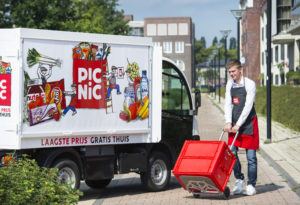In e-groceries home delivery costs remain high. The last mile challenge remains a big one. What are some of the innovative ways that retailers have risen to that challenge? McKinsey partners Louise Herring and Jessica Moulton speak with McKinsey Publishing’s Monica Toriello about how UK grocery retailers can reinvigorate the in-store experience for customers while also making the most of the shift to online food shopping.
High cost
Jessica Moulton about the last mile challenge:” First, let me spend a moment on the financial challenge. For each 80-pound basket, grocers have to pay about five pounds for someone to pick the items off the shelf, and at least another five pounds for someone to deliver it—so that figure is higher, maybe around eight pounds. Obviously, 11 pounds or more is far more than the delivery fee. This is quite a challenge for the grocers.
Drop density
They’ve attempted to solve it through a number of means. The biggest one is by trying to increase drop density. There are some interesting models out there that assist in this. One we think is particularly interesting is the milkman model, which is being used by a small company called Picnic in the Netherlands, that offers only two slots per week to the customer instead of the typical 24 or 32.
Choice for customers
With that kind of reduction in choice for the customer, Picnic is able to get their drop density up to 14 drops per hour, which is seven times higher than the UK average. That’s quite transformative. There are a number of models out there. We think we’ll see a lot more activity in this space, particularly as third-party delivery companies continue to evolve and develop and are able to offer increasingly dense networks.
Uberfication
We’re experimenting in China, where Digital McKinsey is developing an app that’s helping merchants link up with logistics companies and also trucking fleets in order to share their capacity. We think this will allow fleet costs to be reduced by as much as 30 percent. It’ll also avoid cancelled orders and other customer frustration.


Last mile delivery expenses can effect overall supply chain cost. These tips are very useful. Thanks for sharing.